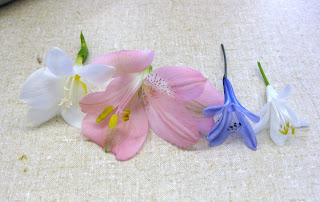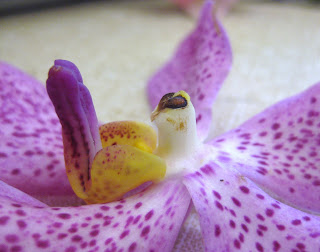Thursday, July 22, 2010
Wednesday, July 21, 2010
LAB 6
FAMALY ASTERACEAE
---
Composite flower head of a sun flower.
Cross section of the composite head; where are the disk floret, ray floret, bract, receptacle?
This is a disk floret, is it male or female? (do you see the anther AND stigma?) The hair at the top of the ovary is called pappus (they are the reduced sepals).
A ray floret; one of its purposes is to attract insects. This floret only has a pistil (no stamen), so it's imperfect.
What kind of symmetry does this floret display?
FAMILY POACEAE
---
"Grass" family
Each of the circled structures is a floret, and the stem-like structure linking them together is called the rachilla. Glumes (removed) would surround these florets.
Dissecting open one of the florets reveals 2 stamens, one pistil and an ovary.
I suspect one stamen is missing because monocots parts are usually in 3's.
A closer look at the top of the ovary reveals the stigma and style. (Thank you to Queenie for the photo)
Parallel veins of a grass blade (it's a monocot)
LILY-LIKE MONOCOTS (FAMILY LILIACEAE AND FRIENDS)
---
Note the lack of sepal, what happened to the structure?
6 stamens
This one also has 6 stamens
Tepals - the fusion of petals and sepals
Family Orchidaceae
An orchid flower
Can you name the floral parts from the above 2 pictures? tepal, column, labellum, pollinia
Labellum (purple, on the left) and column (white, on the right)
What makes up the labellum? and column?
A closer look at the pollinia
Monday, July 19, 2010
LAB 5
FAMILY APIACEAE
---

A fennel plant; one of the many members of the Apiaceae family. Can you make out the following structures? Sheathing petiole, umblet, ray.
This clusters of flowers is called an umblet. Notice the actinomorphic floral arrangement.

This photo shows the 5 stamen that are within each flower. The curled up structures adjacent to each stamen
are its petals. A gap separates each petal, making them "free" or "unfused"
The two segments of the stylopodium are within the petals. You may be able to make out the 2 segments.
A longitudinal section through one of the flowers reveal to oval grooves. This indicates it had 2 carpels within its pistil. The next photo shows the cross section view of these 2 spaces.
The next 2 photos are some leaves of this family.
3 leaves seems to form one bigger leaf, are these leaves compound or simple?
FAMILY LAMIACEAE
---
The family with members that are usually aromatic.

Can you make out the 5 bilabiate petals? The next photo gives a better view. Also, what kind of symmetry does this family have?

Zygomorphic symmetry
This family has 4 stamens.

And a single pistil.
The sepals of the above flower. How many do you see and are they fused?
Leaves from this family. Most of them have surface hairs that secrete aromatic compounds, what are they called?
Glandular and non-glandular trichomes.
FAMILY FABACEAE
---

This flower has the same floral symmetry as the previous family. What is it?

A side view of the same flower.

Can you name all the floral parts in this photo?
Banner (pink), wings (white), keel (greenish), sepals.

How many sepals? One of them is a bit hidden due the angle this photo was taken.

I think this is the most stamen we've seen in a single flower thus far. Fused stamens - the fatter part that stamens are joined to.

That is all for the 3 families!
Bonus family! CHENOPODIACEAE
---
Unfortunely, I do not have much information on this family. If anyone wants to label the above photo of a Quinoa and leave it in the comments that would be great.
Sunday, July 18, 2010
LAB 4
CUCURBITACEAE
---
The flower on this plant was droopy and the number of petals were difficult to count, so the top half was removed.
Only one of the 2 sex organs is found, what's the term used to describe this?
Cross section through a cucumber and a zucchini. 3 fused carpels can be seen here.
SOLANACEAE
---
Here is a flower of Petunia. What is one characteristic that tell you it's a member of the Solanaceae family?
What does the term "actinomorphic" describe?
The next 2 photos shows the back end of the same flower. Note the number of sepals; are they free or fused?
Cross section through the same flower reveals 5 stamens.
(not quite sure where the stigma + style went...I probably dropped/lost it)
Another cross section, and this one has its stigma + style.
Cross section through an unripened tomato reveals 2 carpels.
Brassicaceae
---
This family is known as the crucifers; why is that? hint - check out their petals

The flower contains both stamens and pistil; therefore, it is a "perfect" flower.
The 4 sepals of the flower. They are considered "free" because they broke off individually.
The root of a Wasabi plant

Some leaves from this family
Subscribe to:
Posts (Atom)












































